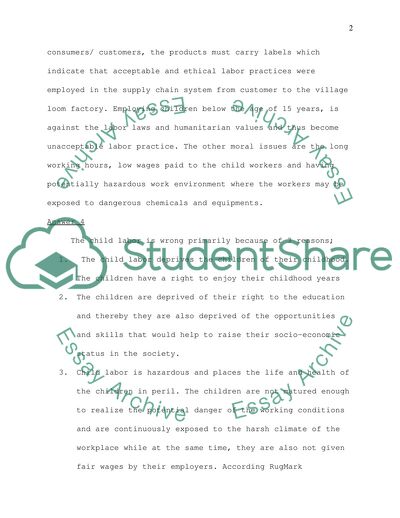
- Home
- Free Samples
- Premium Essays
- Editing Services
- Extra Tools
- Essay Writing Help
- About Us
- Studentshare
- Subjects
- Miscellaneous
- International Management Ethics & Values
International Management Ethics & Values - Essay Example

- Subject: Miscellaneous
- Type: Essay
- Level: Ph.D.
- Pages: 4 (1000 words)
- Downloads: 0
- Author: uptontalia
Extract of sample "International Management Ethics & Values"
the exporters for providing carpets made under internationally acceptable labor practices and when they are found to employ child workers in their looms, the exporter loses the license to use RugMark label and thereby village contractor also loses valuable order or work. The family of the child worker may also be considered as a loser as they also become beneficiary of the income earned by the child workers. In the carpet industry, the main ethical issue is that of employing child workers in their looms.
For the enlightened consumers/ customers, the products must carry labels which indicate that acceptable and ethical labor practices were employed in the supply chain system from customer to the village loom factory. Employing children below the age of 15 years, is against the labor laws and humanitarian values and thus become unacceptable labor practice. The other moral issues are the long working hours, low wages paid to the child workers and having potentially hazardous work environment where the workers may be exposed to dangerous chemicals and equipments. 3. Child labor is hazardous and places the life and health of the children in peril.
The children are not matured enough to realize the potential danger of the working conditions and are continuously exposed to the harsh climate of the workplace while at the same time, they are also not given fair wages by their employers. According RugMark foundation, children are ‘subject to malnutrition, impaired vision and deformities from sitting long hours in cramped loom sheds. They suffer respiratory diseases from inhaling wool fibers and wounds from using sharp tools’ (RugMark foundation).
RugMark was established in 1994 by humanitarian organizations in Germany, with the support of the government. The primary objective of the organization was to dissuade the carpet manufacturers from using child labor in the production of the carpet. In the 2002 report Aparna Ravi reasserts that ‘RugMark was established .
...Download file to see next pages Read MoreCHECK THESE SAMPLES OF International Management Ethics & Values
International Management Ethics and Values
International Management Ethics and Values
International Mangement of Ethics and Values
International Management Ethics and Values
The Nature of Sales Ethics
International Management Ethics and Values: Reflective Journal
International Management Ethics and Values of the Coca-Cola
Ethics and Values of International Management

- TERMS & CONDITIONS
- PRIVACY POLICY
- COOKIES POLICY